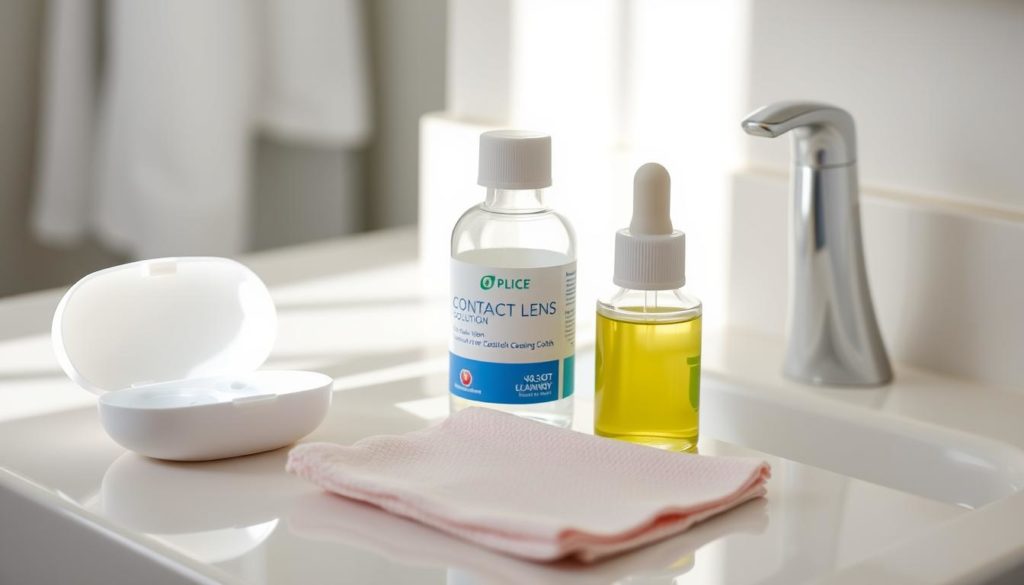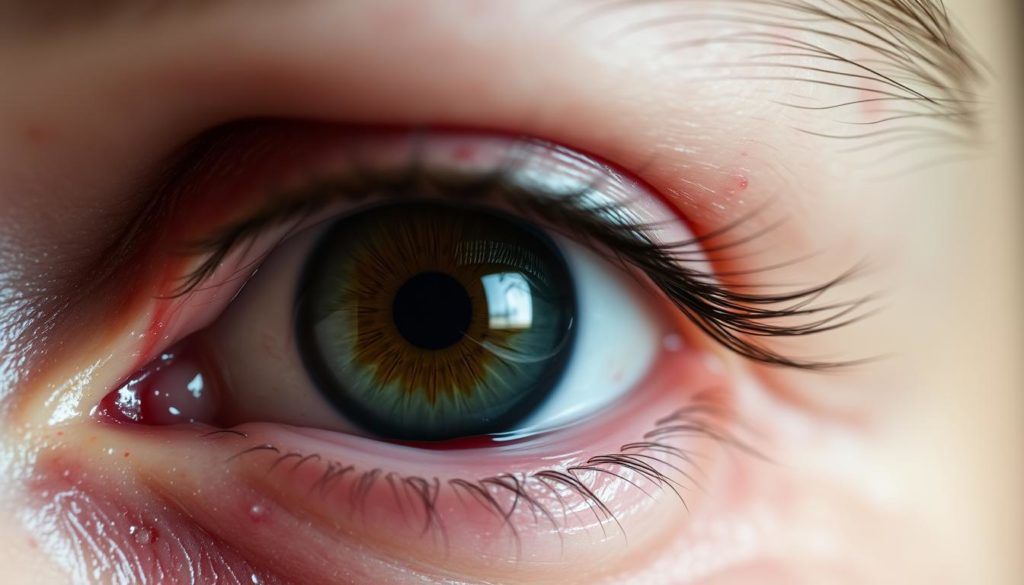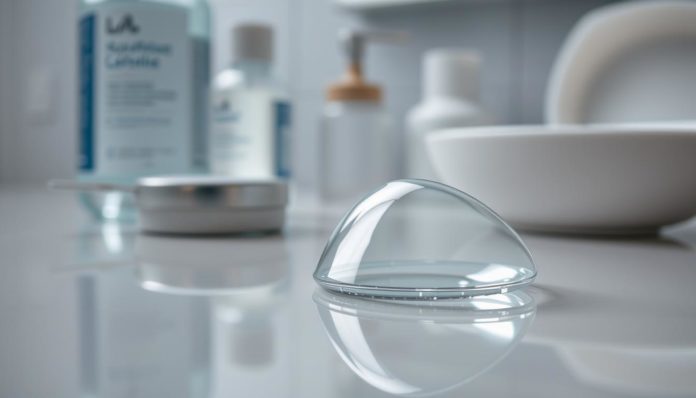Did you know that about 1 in every 500 contact lens users gets a serious eye infection each year? It’s important to know how to care for your contact lenses. Not doing so can lead to serious problems that might harm your vision.
Eye infections are not just uncomfortable. They can also cause lasting damage if not treated right. Ignoring good contact lens care invites infections into your eyes. So, following the advice of eye care experts can help a lot. Keep reading to learn how to keep your eyes safe and your contact lenses clean.
Importance of Contact Lens Hygiene
Keeping your contact lenses clean is key for eye health. Washing your hands before touching your lenses is a simple yet crucial step. It stops dirt, oils, and germs from getting into your eyes, lowering infection risks.

Many studies stress the need for contact lens hygiene. They link good hygiene to fewer eye infections. Always clean and disinfect your lenses with the right solutions to avoid contamination.
| Hygiene Practice | Impact on Eye Health |
|---|---|
| Proper Handwashing | Reduces the transfer of pathogens to the eyes |
| Using Sterile Solutions | Prevents lens contamination and bacterial growth |
| Regular Lens Cleaning | Removes debris and microorganisms from lenses |
Good hygiene practices are vital for eye health. By following these steps, you can greatly lower infection risks. This ensures your contact lens care routine supports your vision health for the long term.
Common Symptoms of Eye Infections
It’s important to know and spot eye infections early, especially if you wear contact lenses. Here are some common symptoms to watch for to keep your eyes healthy:
Redness and Irritation
Redness and irritation are often the first signs of an eye infection. These can happen when bacteria or viruses get on your contact lenses. If you keep seeing redness or irritation, it might mean you have an infection that needs a doctor’s help.
Blurred Vision
Blurred vision is a symptom you shouldn’t ignore. It can mean the cornea is infected, affecting your vision. If your vision gets blurry while wearing contact lenses, see an eye doctor right away for a check-up.
Discharge from the Eye
Seeing an unusual discharge from your eye is a big sign of infection. This discharge might be sticky or watery, as your body tries to fight off the infection. Catching eye infections early is key to avoiding bigger problems.

| Symptom | Description |
|---|---|
| Redness and Irritation | Inflammation and discomfort in the eye. |
| Blurred Vision | Difficulty seeing clearly, indicating potential corneal involvement. |
| Discharge from the Eye | Abnormal secretion, suggesting an ongoing infection. |
Steps for Proper Contact Lens Care
Keeping your contact lenses clean is key to avoiding eye infections and keeping your eyes healthy. Here’s a detailed guide on how to clean, disinfect, store, and replace your lenses.
Cleaning and Disinfecting
Start by cleaning and disinfecting your lenses every day. Use a good lens solution to get rid of dirt and germs. Even if you’re using a no-rub solution, gently rub the lenses with your fingertips. This helps clean them well.
Storage Tips
Keeping your storage case clean is as important as cleaning your lenses. Change your case every three months to prevent germs. Always use new solution to keep your lenses moist and germ-free. Don’t add more solution to old one, as it can grow bacteria. Storing your lenses right keeps them safe to wear.
Regular Replacement Schedule
Following a regular replacement schedule is crucial for your eye health. Whether you wear daily, weekly, or monthly lenses, always follow your eye doctor’s advice. Wearing lenses too long can cause discomfort or infections from protein buildup and germs.
“Consistency in cleaning contact lenses not only improves vision but also significantly reduces the risk of eye infections.” – Dr. Sarah Miller, Optometrist
| Step | Description |
|---|---|
| Cleaning | Use lens solution and rub lenses with your fingertips. |
| Disinfecting | Soak lenses in fresh solution for the recommended period. |
| Storing | Replace storage case every three months and always use fresh solution. |
| Replacement | Stick to your lens replacement schedule as advised by your optometrist. |
Risks of Poor Contact Lens Hygiene
Not following proper hygiene when handling contact lenses can harm your eyes. Neglecting cleanliness can lead to serious problems like corneal ulcers and severe eye infections. These issues can affect your vision and eye health.
A study by the American Academy of Ophthalmology found many problems come from not knowing how to care for lenses. It shows how important it is to avoid contact lens risks by cleaning and storing them correctly.
“Inadequate contact lens hygiene is a leading cause of preventable eye infections,” notes Dr. Thomas Steinemann, a clinical spokesperson for the American Academy of Ophthalmology.
Not cleaning lenses properly can let harmful bacteria into your eyes. This can cause painful infections that threaten eye care safety. It’s crucial to know these risks and stay careful with your lenses every day.
- Always wash hands before handling lenses.
- Use only recommended solutions for cleaning and storing lenses.
- Never reuse or top-off old solution in the lens case.
- Replace your lens storage case regularly to mitigate contamination risk.
By following these simple steps, you can greatly reduce hygiene negligence and improve eye care safety. Always stay informed and watchful to avoid these serious contact lens risks.
Contact Lenses and Eye Infections
Using contact lenses is very convenient. But, it’s key to know the risks, especially eye infections. These infections often come from poor hygiene. Keeping your contact lenses clean can help avoid eye infections.
Studies show a link between bad contact lens use and eye infections. For example, the CDC found many users don’t wash their hands before touching their lenses. This is a big no-no.
- Failing to clean and disinfect contacts properly
- Not following a regular replacement schedule
- Using tap water for lens storage
Knowing the main causes of these infections is crucial. Bacterial and fungal keratitis are common problems from bad hygiene. Here’s a table showing the main causes and symptoms:
| Type | Causes | Symptoms |
|---|---|---|
| Bacterial Keratitis | Pseudomonas aeruginosa, Staphylococcus aureus | Redness, pain, blurred vision |
| Fungal Keratitis | Fusarium, Aspergillus | Eye discharge, swelling, sensitivity to light |
The best way to prevent infections is to follow lens care rules. Use the right cleaning solutions, don’t wear lenses overnight, and get regular eye exams. By doing these things, you can lower your risk of eye infections and still enjoy wearing contact lenses.
Understanding Bacterial Keratitis
Bacterial keratitis is a serious eye infection often caused by bad contact lens habits. Knowing its causes and symptoms is key to getting the right treatment fast. Let’s explore what you need to know about bacterial keratitis.
Causes
Wearing contact lenses the wrong way is a big reason for bacterial keratitis. Not cleaning them right, or using dirty water or solutions, can spread bacteria. Eye injuries and health problems can also increase your risk.
Symptoms
Symptoms of bacterial keratitis show up fast and can be severe. You might feel a lot of pain, see redness and swelling, and have blurry vision. You might also notice discharge and be very sensitive to light. If you see any of these, get help right away.
Treatment Options
Getting treatment for eye infections quickly is very important. For bacterial keratitis, doctors usually give antibiotic eye drops. Sometimes, you might need oral antibiotics or even stay in the hospital. Always stick to your treatment plan to heal fully.
Fungal Keratitis: What You Need to Know
Fungal keratitis is a serious eye infection linked to contact lens use. It’s important to know its causes, symptoms, treatment, and prevention. This knowledge helps keep your eyes healthy.
Causes and Risk Factors
Fungal keratitis happens when fungi get into the cornea. This can be due to eye injuries or wearing contact lenses. Poor hygiene and wearing lenses too long increase the risk.
Exposure to contaminated water and eye trauma also play a part. Trauma, especially with organic materials, can introduce fungi to the eye.
Signs and Symptoms
Knowing the symptoms of fungal keratitis is crucial. Look out for:
- Severe eye pain and redness
- Blurred vision
- Excessive tearing or discharge
- Sensitivity to light
Seeing an eye care professional early can greatly improve treatment outcomes. If you notice these symptoms, don’t hesitate to seek help.
Treatment and Prevention
Treatment for fungal keratitis includes antifungal eye drops and sometimes oral meds. In severe cases, surgery might be needed. To avoid fungal infections, follow these tips:
- Keep contact lenses clean and hygienic.
- Don’t wear lenses while swimming or in hot tubs.
- Use only sterile solutions for lenses, not tap water.
- Replace lenses and cases as advised.
- Wash hands before touching lenses.
Following these steps can help prevent fungal keratitis and keep your eyes healthy.
Choosing the Right Contact Lens Solution
Choosing the right contact lens solution is key for eye health. These products keep your lenses clean and prevent infections. They remove protein buildup, debris, and microorganisms. With many options, picking the right one can be tough.
Understanding the ingredients and their benefits is important. This helps you make a choice that fits your needs and lens type.
Multi-purpose solutions, like those from Bausch & Lomb or Alcon, clean and disinfect in one step. But, if your eyes are sensitive, hydrogen peroxide-based solutions might be better. Clear Care offers these, which are preservative-free and less likely to irritate.
Always talk to your eye care provider for advice. They can recommend based on your lenses and needs.
It’s also important to stay updated on product recalls and reviews. Eye care experts offer great advice. Keeping up with the latest news can help avoid risks from faulty solutions.
In the end, the right contact lens solution is crucial for your eye health. It helps prevent infections and keeps your vision clear.
FAQ
How can I prevent eye infections from contact lenses?
Preventing eye infections starts with good contact lens care. Always wash your hands before touching your lenses. Clean and disinfect them as directed, and store them right. Stick to the replacement schedule your eye care professional recommends.
What are some good hygiene practices for contact lens care?
Good hygiene is key. Wash your hands before touching your lenses. Use the right contact lens solutions for cleaning and storage. Never use tap water to clean lenses. These steps keep your eyes healthy and prevent infections.
What are common symptoms of eye infections related to contact lenses?
Common symptoms include redness, irritation, blurred vision, and discharge. If you notice these signs, remove your lenses and see an eye care professional right away.
How should I clean and disinfect my contact lenses?
Use a recommended contact lens solution to clean and disinfect your lenses. Rub and rinse them with the solution. Replace the solution in the lens case daily. Never reuse old solution. Follow the cleaning instructions from your lens manufacturer.
What are some tips for storing contact lenses?
Store your lenses in a clean, dry case with fresh solution. Replace the case every three months. Never use tap water to rinse the case or lenses. Keeping everything clean is crucial to prevent infections.
Why is a regular lens replacement schedule important?
Following a replacement schedule keeps your lenses safe and effective. Worn out lenses can harbor bacteria, leading to serious infections. Always follow your eye care professional’s advice on when to replace your lenses.
What are the risks of poor contact lens hygiene?
Poor hygiene can cause serious eye problems, like corneal ulcers and infections. Neglecting proper care increases contamination risks. Good hygiene is essential for eye safety.
How are contact lenses related to eye infections?
Contact lenses can harbor bacteria and fungus if not cleaned and stored properly. Poor hygiene and care can lead to infections. Keeping lenses clean and following care guidelines is vital.
What causes bacterial keratitis and how can it be treated?
Bacterial keratitis often comes from bad lens care, like not cleaning them right or using contaminated water. Symptoms include pain, redness, and blurred vision. Treatment usually involves antibiotic eye drops from an eye care professional.
What should I know about fungal keratitis?
Fungal keratitis can come from wearing lenses too long and touching contaminated water or soil. Symptoms include pain, redness, and discharge. Treatment involves antifungal medication and can take weeks or months.
How do I choose the right contact lens solution?
Choose a solution that fits your lens type and needs. Products vary, so talk to your eye care professional. Consider recalls, reviews, and recommendations to make a good choice.


